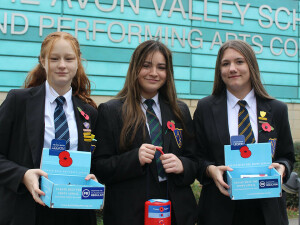Remembrance Activities at The Avon Valley School

Students and staff from The Avon Valley School and Performing Arts College came together on Friday 11th November to continue the school’s annual remembrance tradition.
On the eleventh of November the students gathered in the school’s theatre and watched their peers perform poignant dance and drama pieces which reflect remembrance. These were followed by the last post, exhortation, and a two minute’s silence which was observed by the school’s 1100 students, and staff.
As part of the wider remembrance activities, students used resources from the Commonwealth War Graves Commission to reflect about what remembrance means to each of them, as individuals. Some of the students chose a name of a First or Second World War servicemen, who is buried locally in Rugby, to commemorate and remember whilst other students opted to remember a family member who’s served.
One of those remembered by Avon Valley’s students was Second Lieutenant Douglas Little, a 19 year old pilot, who was killed in June 1918 when the aircraft he was flying crashed. He is buried in Rugby’s Clifton Road Cemetery. Another, of the many servicemen, remembered by the students was Pilot Officer Leslie Mollet a WW2 Canadian aviator from Toronto, who is buried a long way from home, but just a few miles away from the school, at Whinfield Cemetery.
In the week leading up to Remembrance Day members of the school’s student leadership team volunteered their time to sell poppies to their classmates to raise funds for the Royal British Legion. The money raised will be used by the country’s largest armed forces charity who support serving member of the armed forces, veterans and their families.
Alison Davies, Headteacher, said “It is really important that our students take time away from their studies to reflect upon the sacrifice made by those who have served. The students who performed on stage reflected the feeling of remembrance perfectly and were a credit to the school. It was also very interesting to read the tributes written by our students after they’d learnt about the work of the Commonwealth War Graves Commission and had found out about the war graves that can be found locally.”
